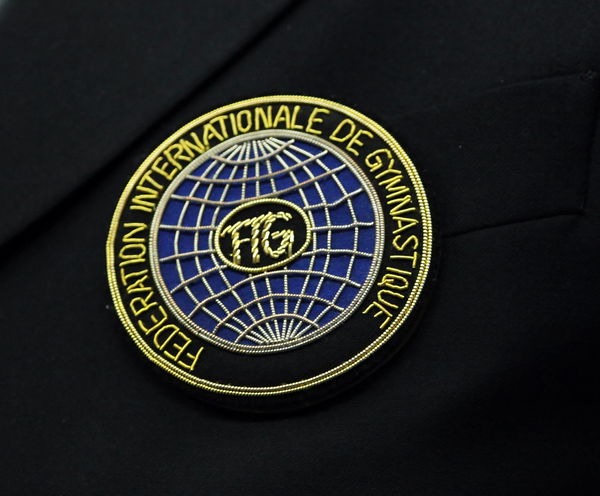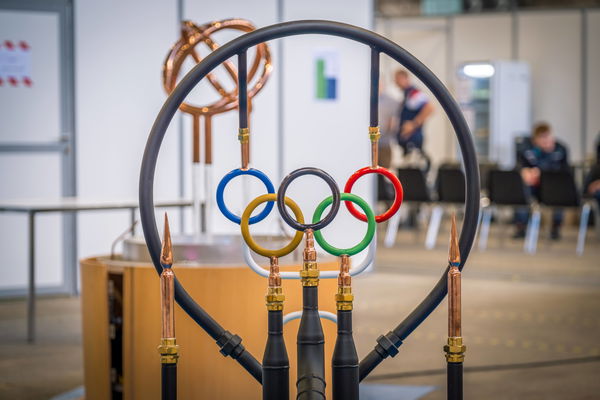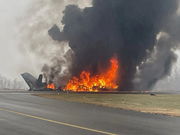
Imago
Bildnummer: 06593495 Datum: 26.09.2010 Copyright: imago/Schreyer shadow of Irina Tshashtshina, RUS, during the closing gala show at the Rhythmic Gymnastics World Championships 2010 in Moscow; 26/09/2010 ; ; Rhythmische Sportgymnastik RSG Gymnastik WM Moskau Damen Abschlussfeier Feier vdig xng 2010 quer Gymnastik RG RSG Rhythmische Sportgymnastik rhythmic gymnastics Frauen Mädchen girls women woman gymnastique rhythmique WM World Championships worlds 2010 Russia Moskau Moscow apparatus closing ceremony show Abschlussfeier Gala Olympiski Komplex playerRUS Irina Tshashtshina Chashchina shadow Schatten Federation Internationale de Gymnastique o0 Symbol Sportgymnastin Gymnastin Logo Emblem Objekte Verband FIG Schatten, Schattenspiel Image number 06593495 date 26 09 2010 Copyright imago Schreyer Shadow of Irina Tshashtshina RUS during The Closing Gala Show AT The Rhythmic Gymnastics World Championships 2010 in MOSCOW 26 09 2010 Rhythmic Gymnastic RSG Gymnastics World Cup Moscow women Closing Ceremony Celebrations Vdig 2010 horizontal Gymnastics RG RSG Rhythmic Gymnastic Rhythmic Gymnastics Women Girl Girls Women Woman Gymnastique Rhythmique World Cup World Championships Worlds 2010 Russia Moscow MOSCOW apparatus Closing Ceremony Show Closing Ceremony Gala Olympiski Complex playerRUS Irina Tshashtshina Shadow Shadow Federation International de Gymnastique o0 symbol Sportgymnastin Gymnastin emblem Emblem Objects Association FIG Shadow Shadow play

Imago
Bildnummer: 06593495 Datum: 26.09.2010 Copyright: imago/Schreyer shadow of Irina Tshashtshina, RUS, during the closing gala show at the Rhythmic Gymnastics World Championships 2010 in Moscow; 26/09/2010 ; ; Rhythmische Sportgymnastik RSG Gymnastik WM Moskau Damen Abschlussfeier Feier vdig xng 2010 quer Gymnastik RG RSG Rhythmische Sportgymnastik rhythmic gymnastics Frauen Mädchen girls women woman gymnastique rhythmique WM World Championships worlds 2010 Russia Moskau Moscow apparatus closing ceremony show Abschlussfeier Gala Olympiski Komplex playerRUS Irina Tshashtshina Chashchina shadow Schatten Federation Internationale de Gymnastique o0 Symbol Sportgymnastin Gymnastin Logo Emblem Objekte Verband FIG Schatten, Schattenspiel Image number 06593495 date 26 09 2010 Copyright imago Schreyer Shadow of Irina Tshashtshina RUS during The Closing Gala Show AT The Rhythmic Gymnastics World Championships 2010 in MOSCOW 26 09 2010 Rhythmic Gymnastic RSG Gymnastics World Cup Moscow women Closing Ceremony Celebrations Vdig 2010 horizontal Gymnastics RG RSG Rhythmic Gymnastic Rhythmic Gymnastics Women Girl Girls Women Woman Gymnastique Rhythmique World Cup World Championships Worlds 2010 Russia Moscow MOSCOW apparatus Closing Ceremony Show Closing Ceremony Gala Olympiski Complex playerRUS Irina Tshashtshina Shadow Shadow Federation International de Gymnastique o0 symbol Sportgymnastin Gymnastin emblem Emblem Objects Association FIG Shadow Shadow play
Russian and Belarusian gymnasts are about to reappear on the world stage for the first time in three years, but their return has not been greeted with universal approval. When the International Gymnastics Federation (FIG) opened the door in January for athletes from the two nations to compete under neutral status, it appeared to mark a quiet resumption of normality. Yet the announcement that five athletes have registered for this month’s FIG World Challenge Cup in Paris has instead revived one of the sport’s most politically charged disputes.
Watch What’s Trending Now!
The original ban, enacted in March 2022, had excluded both athletes and officials from all FIG events. That restriction remained in place until the beginning of 2024, when the federation introduced a framework for “individual neutral athletes” stripped of flags, uniforms, and national anthems. Even under those conditions, participation comes with strict rules: No team entries, no display of national symbols, and no involvement of sanctioned officials. Still, for many observers, the policy’s technical neutrality cannot separate competition from the ongoing reality of war.
Among the most prominent voices of dissent is Lilia Podkopayeva, Ukraine’s celebrated 1996 Olympic all-around champion. Speaking with Forbes after the registrations were confirmed, she called the decision a profound mistake. She argued that sport cannot function in isolation from armed conflict, noting that every medal secured by Russian or Belarusian athletes risks being used as a political instrument.
ADVERTISEMENT
Podkopayeva pointed out how the situation renders international competition morally untenable. For her, the injustice lies not merely in symbolism but in lived reality. It is a contrast that, in her view, discredits the values sport is meant to preserve.
As she put it directly to the governing body, “I urge (International Gymnastics Federation) and the sporting community to draw a clear moral line: protecting sport begins with protecting human life.”

Imago
41st World Gymnastics Championships in London Logo of the International Federation of Gymnastics in the Artistic World Gymnastics Championships at the O2 Arena in London, Britain, 18 October 2009. The 41st Artistic World Gymnastics Championships are taking place in the English capital from the 13th to the 18th of October 2009., Credit:FELIPE TRUEBA / Avalon UNITED KINGDOM PUBLICATIONxNOTxINxUKxFRAxUSA Copyright: xFELIPExTRUEBAx/xAvalonx 0559784465
Her statement aligns with the Ukrainian Gymnastics Federation’s broader stance, which has consistently pressed international organizations to maintain sanctions until hostilities cease. While FIG maintains its framework of neutrality, Podkopayeva’s objections illustrate how fragile that notion remains.
ADVERTISEMENT
For the gymnasts now preparing to compete in Paris, the event is an opening to return to their craft. For others, it represents the blurring of a line between athletic competition and geopolitical accountability that should never be crossed. And if you remember, before the Paris Olympics unfolded, only one Russian and two Belarusian gymnasts earned the IOC’s approval to compete there after enduring a rigorous vetting process.
ADVERTISEMENT
How three gymnasts cleared IOC’s strict vetting to compete in Paris under neutral status
Three gymnasts, one Russian and two Belarusian, eventually reached the Paris Games, but their path to the arena was marked by a deliberate and exacting review.
The International Olympic Committee had insisted upon a two-tier examination, which determined eligibility on the basis of conduct, affiliations, and adherence to the principles of the Olympic Movement. Only those who could withstand such scrutiny were permitted to step forward. This narrow passage was not designed to be generous, but rather to guarantee that the appearance of these athletes would not contradict the declared mission of neutrality.
ADVERTISEMENT

Imago
Dritter Wettkampftag der WorldSkills 2024 in Lyon. Olympia Logo und die Stahlbetonbauer World Skills 2024 – Tag 3 *** Third day of competition at WorldSkills 2024 in Lyon Olympic logo and the reinforced concrete workers World Skills 2024 Day 3
The Gymnastics Committee introduced stipulations that reshaped the very framework of their participation. The gymnasts entered as Individual Neutral Athletes, stripped of the emblems and sounds that ordinarily define representation. They could not join a national roster, nor could they march at the opening ceremony among their peers. Uniforms were shorn of familiar colors, and medals, if earned, accrued only to their names rather than a national tally.
Top Stories
Jake Paul vs. Anthony Joshua Fight Purse: How Much Are Alycia Baumgardner and Others Earning?

Greg Biffle Plane Tragedy: What Might Have Caused the Crash That Killed the NASCAR Champ and His Family

Josh Allen Makes Lifetime Buffalo Announcement as Pregnant Hailee Steinfeld Receives Bills QB’s Clear Family Plan

Calls Mount Against Referee Over “Terrible” Alabama Call That Could Cost Kalen DeBoer

Another Almost Fatal Disaster Surfaces From Statesville Airport Amidst Ongoing Greg Biffle’s Crash Investigation

“The Biff”: NASCAR Fans Push for Legacy-Defining Award Named After Greg Biffle Following His Tragic Death

As the IOC explained, “They would have to refrain from sporting any emblems, anthems, or flags.” The absence of such markers was not incidental. It underscored the insistence that their presence should be athletic rather than political.
ADVERTISEMENT
Even the invitation to compete did not arrive without conditions. Each athlete had to affirm a declaration of support for the peace mission of the Olympic Movement, thereby binding their performance to a wider symbolic charge. The arrangement left them visible, yet distanced, as they moved through a tournament where recognition was personal but detached from the collective identity of their homelands. The measures were both restrictive and defining, shaping their journey in Paris as one of profound individuality within the framework of international sport.
ADVERTISEMENT
ADVERTISEMENT
ADVERTISEMENT

